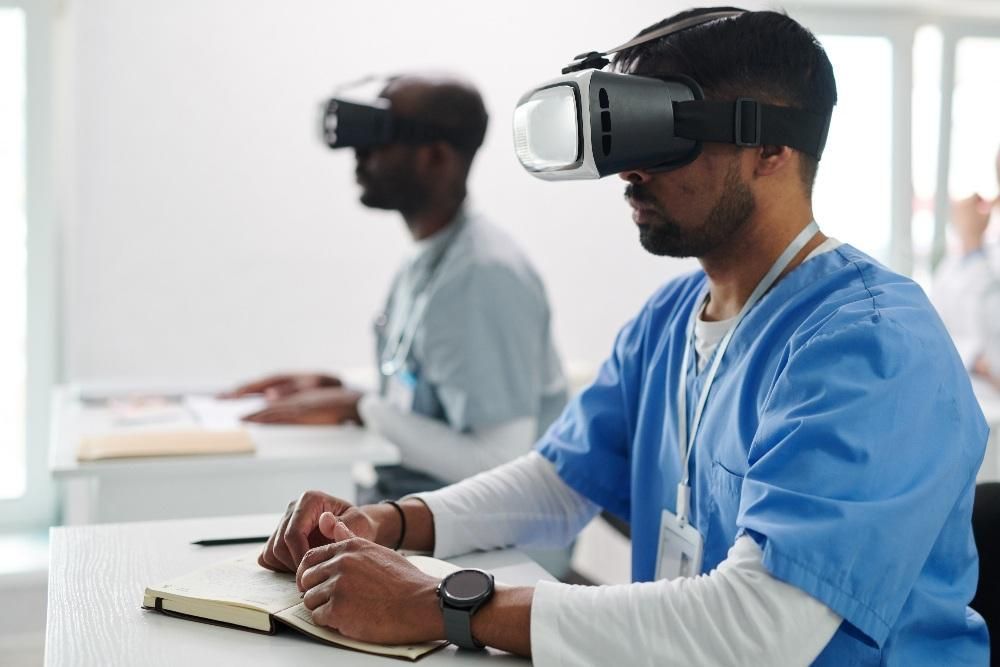A Guide to Enhancing Healthcare Simulation Through Gamification
In the ever-evolving landscape of healthcare education, gamification, a dynamic and alluring approach, injects fun, competition, and engagement into healthcare simulations. Medical simulation has become a cornerstone for training healthcare professionals. Clinical simulation offers a safe and controlled environment for learners to hone their skills before they step into real-life medical situations. However, even the most engaging clinical simulation can benefit from a little extra spark to captivate learners and maximize the educational experience. This HealthySimulation.com article by Rebecca Cicero, CHSOS, will explore how to incorporate gamification in healthcare simulation to enhance commitment and improve learning outcomes.
Gamification is the integration of game-like elements into non-game contexts to engage users and motivate them towards specific goals. In healthcare simulation, these game elements can range from points and rewards to competition and storytelling. By harnessing the principles of gamification, educators can create a more immersive and enjoyable learning experience. Gamification can transform what might otherwise be a passive learning experience into an active, motivating, and engaging experience.
Incorporating gamification into healthcare simulation is not merely a trend but a strategy that can significantly impact the quality of healthcare education and, consequently, patient outcomes. It enhances engagement, fosters teamwork, and improves learning outcomes. By embracing the principles of gamification, educators can create a dynamic and effective training environment that prepares healthcare professionals for the challenges they will face within a career. As technology advances, the possibilities of gamified healthcare simulations are boundless, offering an exciting future for healthcare education. When using gamification in healthcare simulations, the key is to strike the right balance between fun and education, ensuring that patient safety, ethical considerations, and psychological safety always remain at the forefront.
Sponsored Content:
Learner Engagement Tends Toward Learner Improvement
One of the primary benefits of incorporating gamification into healthcare simulation is the boost in learner engagement. Traditional high-fidelity simulations are undoubtedly valuable, but they sometimes feel detached and lack the emotional investment that real-life situations require. Gamification addresses this issue by making learning more enjoyable, alluring, and interactive.
For instance, create a clinical simulation scenario where learners compete against each other to diagnose and treat a patient under time constraints, which can make the experience much more engaging. Leaderboards and rewards for achieving specific milestones can further fuel the competitive spirit and keep learners invested and interested in the simulation.
Gamification not only increases engagement but also enhances learning outcomes. Learners actively engaging in a simulation are more likely to retain information, practice critical decision-making skills, and gain confidence in their abilities. Gamification encourages learners to revisit and reinforce their knowledge and skills regularly. Through ongoing competitions, leaderboards, and scenarios that evolve with time, healthcare professionals can maintain their proficiency, ensuring they remain effective throughout their careers. Moreover, this long-term engagement can foster a sense of continuous improvement and commitment to delivering the highest quality care to patients. The following strategies can help leverage gamification to improve learning outcomes in healthcare simulation:
Sponsored Content:
- Feedback Loops: Incorporate immediate feedback into the simulation to inform learners of their performance. This allows them to make real-time adjustments and learn from their mistakes, improving their decision-making skills and confidence levels.
- Progression Systems: Implement a progression system where learners must complete a series of increasingly complex scenarios. This mirrors the progression of skills required in the real healthcare setting and ensures a comprehensive learning experience.
- Simulation Scenarios with a Purpose: Integrate a narrative or storyline into the healthcare simulation. This can create a sense of purpose and urgency, making learners feel part of a real medical team with lives depending on their decisions.
Improve Teamwork and Collaboration Skills
In the healthcare field, collaboration and teamwork are vital skills. Gamification can encourage these skills by incorporating cooperative elements into simulations. For example, creating scenarios where learners must work together to diagnose and treat patients fosters a sense of teamwork and communication.
Additionally, team-based competitions can be introduced to simulate the challenges of working in a
high-stress interprofessional medical environment. This helps learners develop their clinical
judgment skills and their ability to collaborate effectively with various colleagues in potentially different medical professions.
Gamification allows for the creation of personalized learning paths within healthcare simulation. Each learner may have unique strengths and areas for improvement. By utilizing gamified elements, like branching scenarios and adaptive challenges, educators can tailor simulations to meet the specific needs of individual learners. This level of personalization keeps learners engaged and ensures they receive targeted training to excel in their roles.
To measure the effectiveness of gamification in healthcare simulation, educators can utilize monitoring and analytics tools. These tools track learners’ progress, performance, and engagement throughout the simulation. By analyzing this data, educators can identify areas where learners excel and areas that need improvement. This feedback can be used to fine-tune the gamification elements for optimal learning outcomes.
View the LEARN CE/CME Platform Webinar The Impact of Serious Games and Gamification in Healthcare and Clinical Education to learn more!
Learning Outcomes and Analytics
Technology plays a pivotal role in the successful implementation of gamification in healthcare simulation. Simulators and software designed for healthcare education can be enhanced with gamified features. Virtual reality (VR) and augmented reality (AR) technologies, for example, can create highly immersive and interactive simulation scenarios. These technologies can also track user progress and provide immediate feedback, enhancing the learning experiences.
While gamification can be a powerful tool for enhancing learning outcomes, maintenance of psychological safety is essential. Special considerations should be considered with attention to ethical considerations. In healthcare simulation, the focus should always be on the well-being and safety of patients and learners. Therefore, gamification elements should align with ethical guidelines and prioritize patient care and learners’ psychological safety about all else.
Ultimately, the goal of incorporating gamification into healthcare simulation is to prepare learners for real-world challenges. Healthcare professionals often face high-stress situations, and gamified simulation can help build their resilience and confidence in making critical decisions. By mastering these skills in a simulated but engaging environment, learners are better equipped to handle the pressures of clinical practice.
Learn More About How Gamification Improves Healthcare Simulation Medical Training!
References:
- Dankbaar, M. E., Alsma, J., Jansen, E. E., van Merrienboer, J. J., van Saase, J. L., & Schuit, S. C. (2016). An experimental study on the effects of a simulation game on students’ clinical cognitive skills and motivation. Advances in Health Sciences Education, 21, 505-521.
- Gentry, S. V., Gauthier, A., L’Estrade Ehrstrom, B., Wortley, D., Lilienthal, A., Tudor Car, L., … & Car, J. (2019). Serious gaming and gamification education in health professions: systematic review. Journal of medical Internet research, 21(3), e12994.
- Deterding, S., Dixon, D., Khaled, R., & Nacke, L. (2011, September). From game design elements to gamefulness: defining” gamification”. In Proceedings of the 15th international academic MindTrek conference: Envisioning future media environments (pp. 9-15).
Rebecca Cicero is a seasoned professional with a passion for the dynamic realm of healthcare simulation. With 14 years of dedicated experience in the field, Rebecca’s commitment to excellence is underscored by her CHSOS certification, a testament to her expertise in healthcare simulation. Known for thriving in fast-paced environments, Rebecca excels at orchestrating intricate simulation scenarios with precision and innovation. Her journey in the health simulation field has been marked by a genuine love for both the simulation process and the students she guides. Rebecca finds joy in witnessing the transformative power of simulation as a tool for learning and skill development. Beyond her technical proficiency, Rebecca is recognized for her creative approach to simulation, infusing scenarios with imagination to enhance the learning experience. Her dedication to advancing healthcare education through simulation has not only made her a respected professional in the industry but also a mentor who takes pride in nurturing the growth of future healthcare simulation professionals.
Sponsored Content:


















